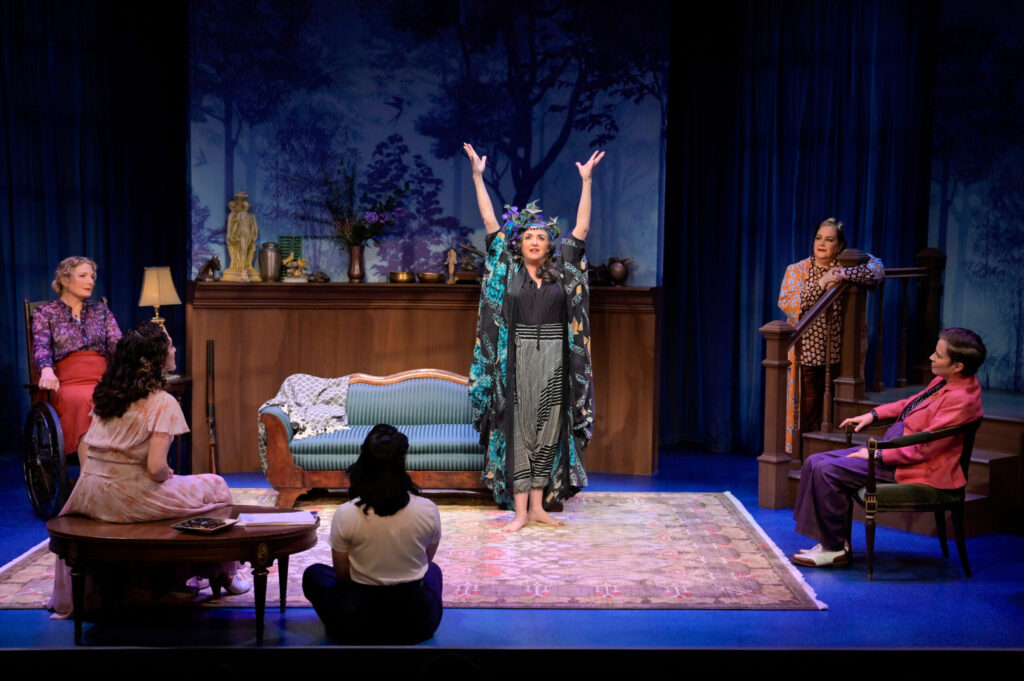
As she welcomes seven luncheon guests into the drawing room of her posh manor house, domineering den mother Fefu dispenses aphorisms like casually tossed grenades.
“My husband married me to have a constant reminder of how loathsome women are,” is her very first line, which Fefu immediately, if unconvincingly, disarms by explaining that she’s not being literal, but is interested in “exciting ideas” and provocations “to grapple with.”
The same can be said for the whole of Fefu and Her Friends, Irene Maria Fornes’ psychosocial puzzle play, now being mounted in a luxe ACT production at the Strand Theater.
Revealing the often ugly underbellies of upper-crusty characters in arch, mannered dialogue (“I’d like it if you’d like me. You think it’s unlikely”) and menacing non-sequiturs that hang in the air like axe blades, this academically heralded but rarely produced play immediately brings to mind the work of Fornes’ admirer, contemporary and fellow trafficker in the domestic oblique, Edward Albee.
That impression is confirmed by a third act piano rendition of Franz Schubert’s setting of Shakespeare’s Two Gentlemen of Verona verse “Who Is Sylvia?”, which poses questions about the potential disjuncture between a woman’s superficial beauty and inner kindness. That poem also happens to provide the subtitle for Albee’s own later play The Goat, or Who Is Sylvia?, one of many Albee works that have been directed, to great acclaim, by A.C.T. Artistic Director—and the director of this production—Pam MacKinnon.
If such echoes and connections summon up your inner literary detective, you’ll feast on Fefu’s immersive ambiguities. But if your taste in theater leans toward meat and potatoes conclusiveness, you’re likely to leave less than sated.

Like a game of Clue, the play’s action takes place in multiple rooms of a house. And while the all-woman cast of seven is remarkably well-balanced, scenic designer Tanya Orellana stands out in a true star turn.
After the opening act, which takes place on the Strand’s main stage, the audience is divided into four groups which are each guided a different location in the building. Backstage, in a tented bedchamber, Julia (Lisa Anne Porter) is tended to by Sue (Leontyne Mbele-Mbong) after being plagued by hallucinations and unspecific memories of a violent attack.
A carpet of astroturf, diorama-like floral displays and an enormous nature video transform the lobby into a garden where Fefu (Catherine Castellanos, wry and commanding) and Emma (Cindy Goldfield, a personified chuckle) have a tete a tete about genitalia.
The black box Rueff Theater on the strand’s third story is divided into two separate settings: A warm dark study piled with books and chessmen where the normies of the gaggle, Cindy (Jennifer Ikeda) and Christina (Sarita Ocón) burrow into oblivion; and a perfectly detailed 1930s kitchen with checkerboard linoleum floor and stamped tin ceilings where lesbians Cecilia (Marga Gomez) and Paula (Stacy Ross) spat and hanker (This diorama like arrangement is reminiscent of Es Devlin‘s design for The Lehmann Trilogy).
Richly detailed costumes by Sarita Fellows and perfect props assembled by Janice Gartin (The cocktail trolley is to die for!) add to the thrill of spending time in these splendid scenarios.
After each subset of the audience has visited this full quartet of scenes, they reconvene in the main auditorium as the cast returns to the main parlor set for a final, if inconclusive, act that incorporates fantastical visions, gunplay and bloodshed.
Written in the 1970s and set in the 1930s, Fornes play is chockful of aperçus about women’s status in bourgeouis America. Many of her characters’ eccentricities seem like blooms that have been forced by a stifling environment. At the same time, Fornes gives these women the rare privilege of commanding the stage on their own. Or perhaps not commanding, but sharing, moving, thinking and regrouping in ways generally unacknowledged both on stage and in society.

